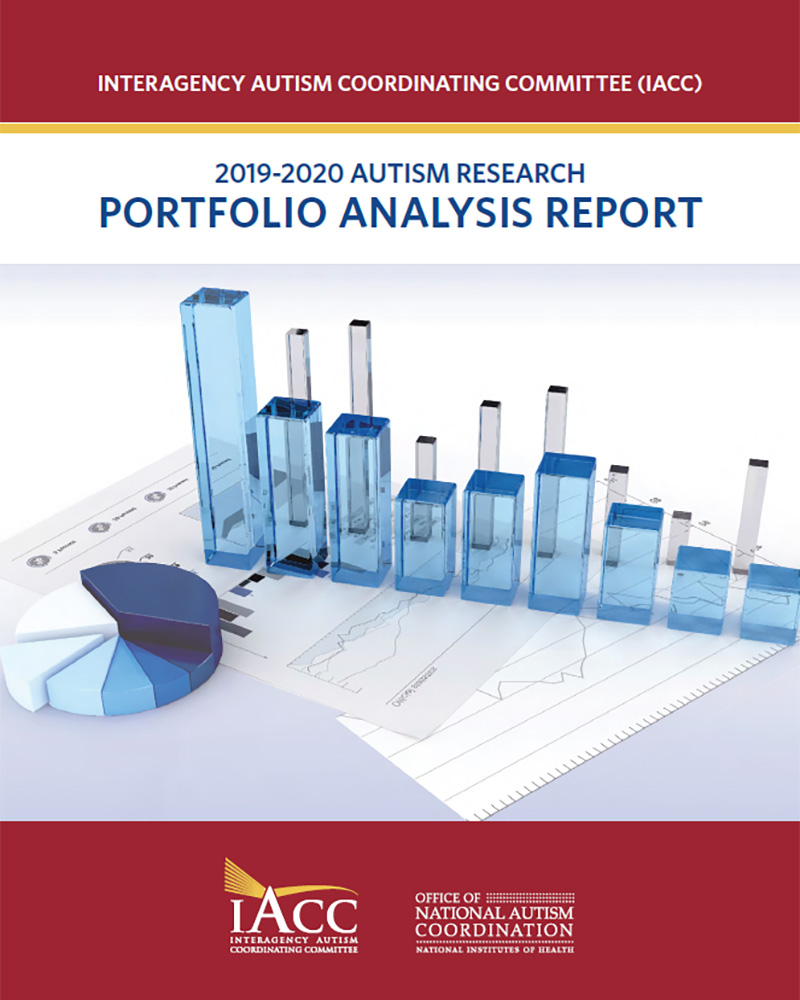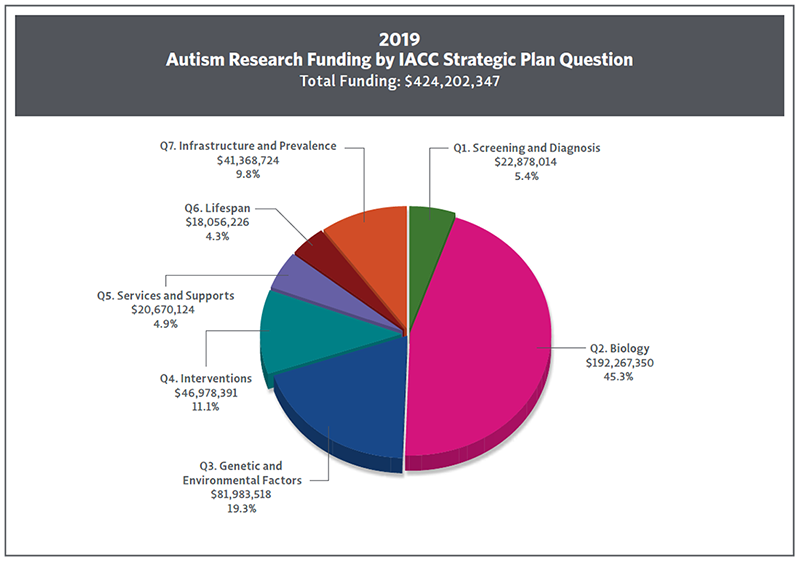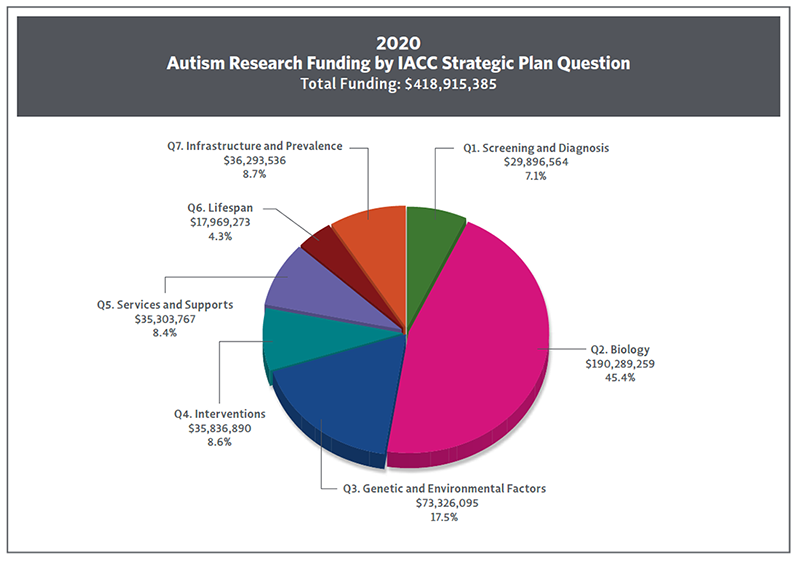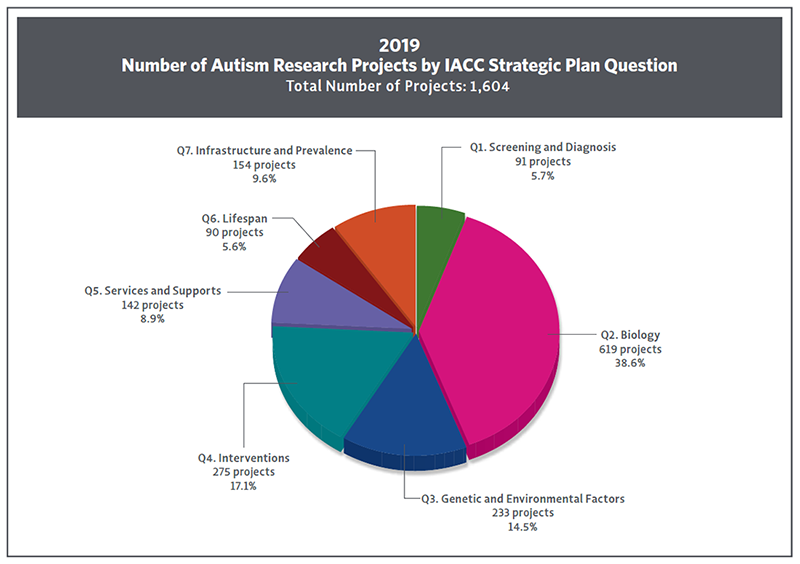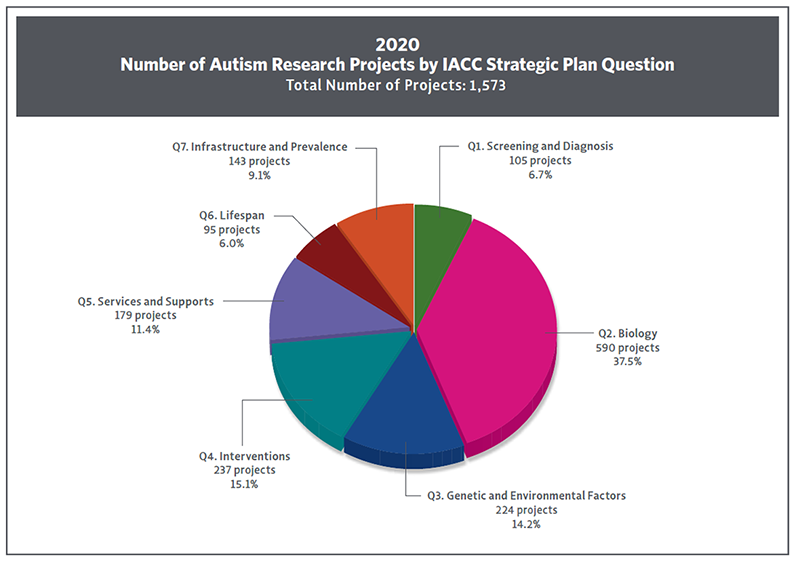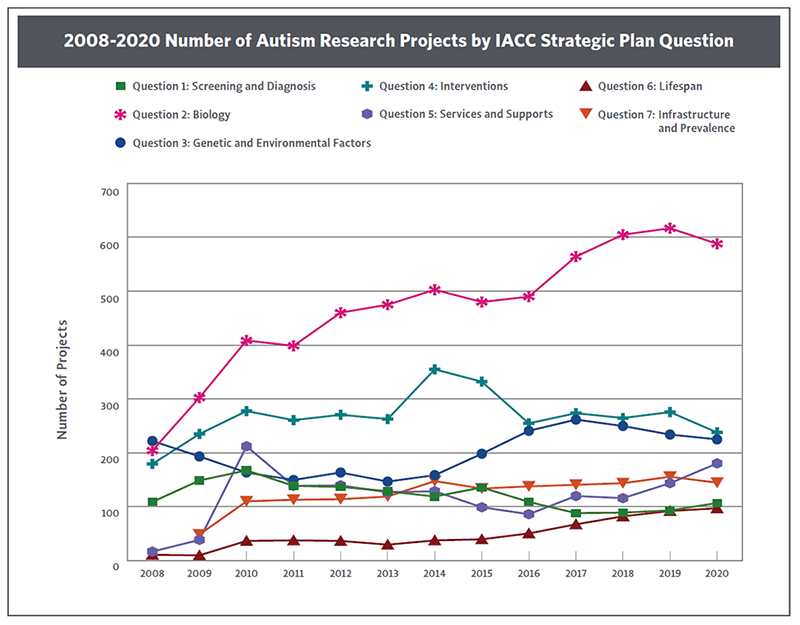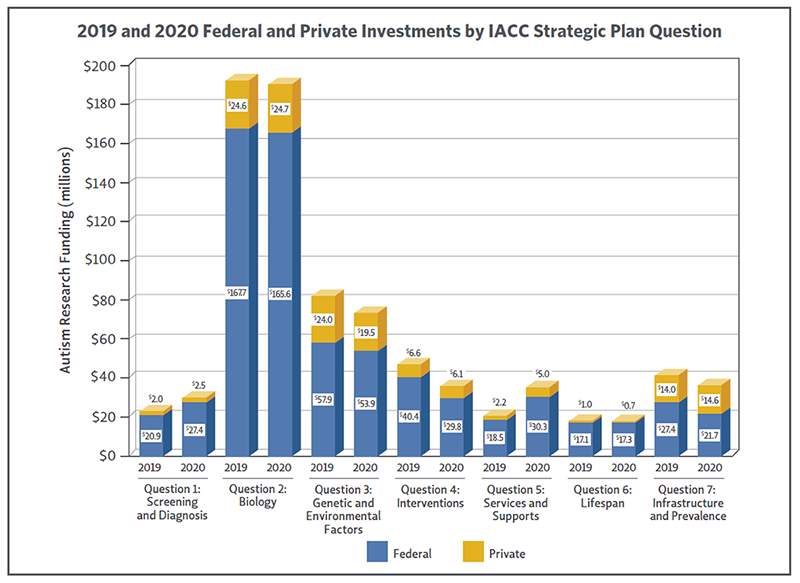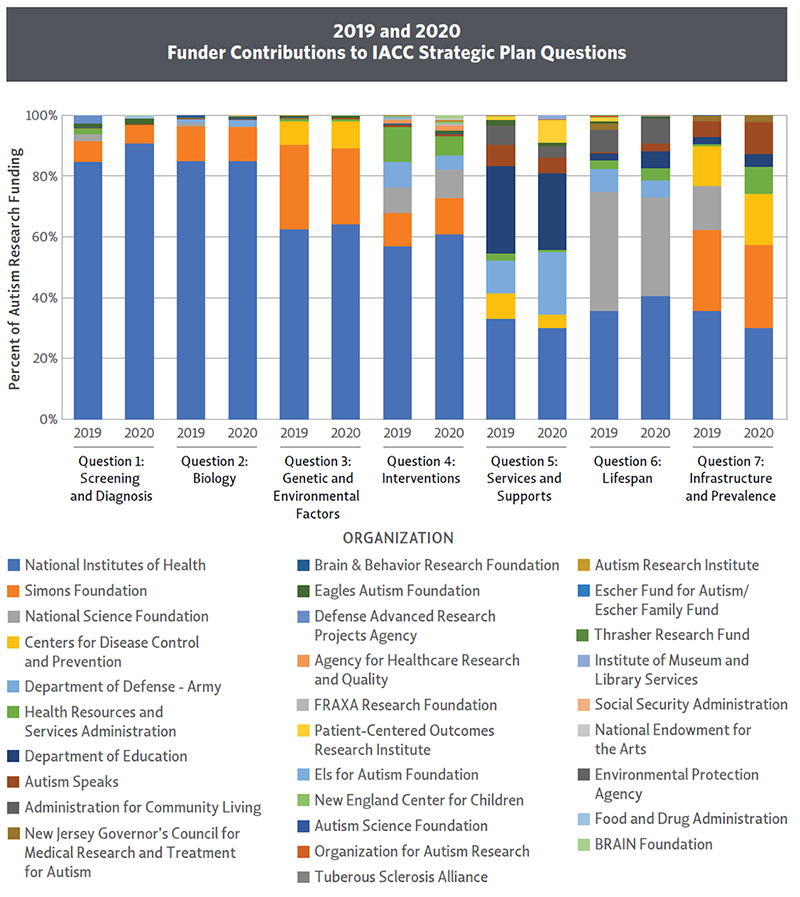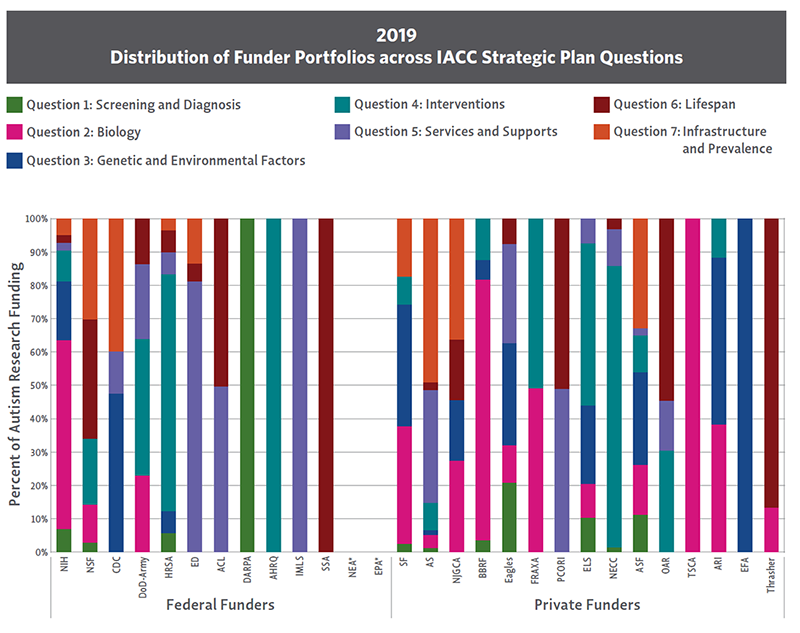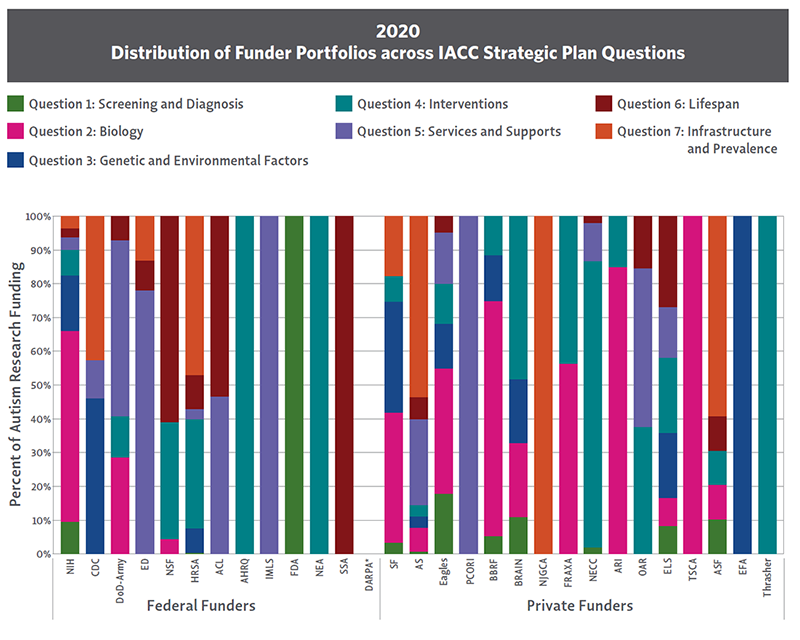Portfolio Analysis Report
IACC Autism Research
2019-2020
Autism Research Areas and Analyses of Funding Over Time
Which areas of autism research were funded in 2019 and 2020?
To better understand which areas of research were funded in 2019 and 2020, projects were aligned with the seven Questions of the 2016-2017 IACC Strategic Plan. Figures 12 and 13 illustrate the breakdown of research funding per each of the Strategic Plan’s Question areas, which are: Screening and Diagnosis (Question 1), Biology (Question 2), Genetic and Environmental Factors (Question 3), Interventions (Question 4), Services and Supports (Question 5), Lifespan (Question 6), and Infrastructure and Prevalence (Question 7). Identifying how research investments correspond to the Strategic Plan provides an understanding of how funders have directed investments to priority areas identified by the IACC, as well as an indication of which areas are well-supported versus those that may need additional attention or development.
Autism research funding in 2019 and 2020 supported projects relevant to all seven Questions in the IACC Strategic Plan. For both 2019 and 2020, the largest portion of funding addressed the underlying Biology of autism (Question 2). This was followed by Question 3 (Genetic and Environmental Factors), research aimed at identifying potential factors that may contribute to autism. In 2019, the percent of total funding aligned with each Question were as follows: Question 1, 5.4%; Question 2, 45.3%; Question 3, 19.3%; Question 4, 11.1%; Question 5, 4.9%; Question 6, 4.3%; Question 7, 9.8% (Figure 12). Similarly, in 2020, the percent of total funding aligned with each Question were: Question 1, 7.1%; Question 2, 45.4%; Question 3, 17.5%; Question 4, 8.6%; Question 5, 8.4%; Question 6, 4.3%; Question 7, 8.7% (Figure 13).
Figure 12. Distribution of 2019 autism research funding by IACC Strategic Plan Question. The seven Questions of the Strategic Plan are represented in the clockwise direction, beginning with Screening and Diagnosis (Question 1) and ending with Infrastructure and Prevalence (Question 7).
Figure 13. Distribution of 2020 autism research funding by IACC Strategic Plan Question. The seven Questions of the Strategic Plan are represented in the clockwise direction, beginning with Screening and Diagnosis (Question 1) and ending with Infrastructure and Prevalence (Question 7).
Another way to evaluate the autism research landscape is to measure the number of research projects funded. When the number of projects is considered, the proportions of each Question area shift due to differences in the relative size and cost of projects falling under each of the topics. In particular, research on Interventions (Question 4) and Services and Supports (Question 5) have greater portions of the whole when the number of projects is considered versus dollar amounts. In 2019, the percent of total projects aligned with each Question were as follows: Question 1, 5.7%; Question 2, 38.6%; Question 3, 14.5%; Question 4, 17.1%; Question 5, 8.9%; Question 6, 5.6%; Question 7, 9.6% (Figure 14). The percent of total projects aligned with each Question were similar in 2020: Question 1, 6.7%; Question 2, 37.5%; Question 3, 14.2%; Question 4, 15.1%; Question 5, 11.4%; Question 6, 6.0%; Question 7, 9.1% (Figure 15). Overall, the proportion of projects in each Question area remained relatively constant from one year to the next.
Figure 14. Number of autism research projects by IACC Strategic Plan Question in 2019.
Figure 15. Number of autism research projects by IACC Strategic Plan Question in 2020.
How has funding for different areas of autism research changed from 2008 to 2020?
The IACC has been tracking how autism research funding and projects align with IACC Strategic Plan Questions for 13 years. Figure 16 shows the funding amount for each Question over time in real dollars (even when adjusted for inflation, the trajectories of growth over time remain the same for each of the seven Question areas). Figure 17 shows the number of projects for each Question area from 2008 to 2020.
Research funding and the number of projects for Question 2 (Biology) has grown substantially from 2008 to 2020. This Question area now makes up almost half of the U.S. autism research portfolio. In 2008, Question 3 (Genetic and Environmental Factors) received the largest amount of funding compared to other Question areas. However, funding and the number of projects for this Question decreased from 2009 to 2014. Since 2014, there has been renewed growth in Question 3 research, and it is the second largest Question area in the U.S. autism research portfolio. Funding for Question 4 (Interventions) remained mostly stable between 2008-2017, though the number of projects did decrease between 2015 and 2016 due to a change in coding to better align projects with the updated Objectives of the 2016-2017 Strategic Plan (see page 63 for more details). Since 2017, there has been a decrease in the dollar amount of Question 4 funding, but the number of projects did not decrease from 2017-2019. Question 5 (Services and Supports) and Question 6 (Lifespan) have historically been the areas that receive the lowest amounts of funding. In recent years, however, funding and the number of projects for both Question areas have been on the rise. Lastly, funding amounts and the number of projects for Question 1 (Screening and Diagnosis) and Question 7 (Infrastructure and Prevalence) have been relatively consistent over the 13-year span.
Subsequent sections in this report provide in-depth analyses of changes in funding over time (2008-2020) for each Question area.
Figure 16. Autism research funding from 2008 to 2020 by IACC Strategic Plan Question.
Figure 17. The number of autism research projects from 2008 to 2020 by IACC Strategic Plan Question.
How many new autism research projects were added to each Question area in 2019 and 2020 compared to ongoing research?
When comparing Strategic Plan Questions, the proportion of new versus ongoing projects is not consistent across all areas of autism research. In comparison to other Question areas, research related to Lifespan (Question 6) and Services and Supports (Question 5) had higher proportions of funding devoted to new projects in 2019 and 2020 (Figure 18). The IACC has emphasized the need to expand research in these areas, highlighted in the 2016-2017 IACC Strategic Plan’s Budget Recommendation. While Question 5 and Question 6 have historically received the least funding compared to other Question areas, the high proportion of newly funded projects on these topics suggests growth that aligns with Strategic Plan recommendations. In contrast, funding for Biology (Question 2) and Genetic and Environmental Factors (Question 3) had the highest proportions of funding going to ongoing projects when compared to other Questions. These two Question areas have historically received the highest amounts of funding and are well established, with many ongoing projects from year-to-year. Future Portfolio Analysis Reports will continue to monitor trends in the distribution of new versus ongoing projects across the portfolio.
Figure 18. Percent of 2019 and 2020 autism research funding directed to ongoing versus new projects varies by Strategic Plan Question area.
What types of autism research are funded by the different agencies and organizations?
The 14 federal and 16 private funders included in the Portfolio Analysis Report fund a wide range of autism research projects. As shown in Figure 19, federal and private funders contributed to funding for each of the Question areas in the IACC Strategic Plan in 2019 and 2020. However, the amount of federal and private funding varies by Question area, as some areas align more closely with federal or private mission areas and priorities. All Question areas received more federal funding than private funding. The research areas that received the largest amounts of federal funding were Biology (Question 2), Genetic and Environmental Factors (Question 3), and Interventions (Question 4). The research areas that received the largest amounts of private funding were Biology (Question 2), Infrastructure and Prevalence (Question 7), and Genetic and Environmental Factors (Question 3).
Figure 19. Federal and private funding was provided for each Strategic Plan Question area in 2019 and 2020, although the amount of federal and private funding varied between Question areas. Funding amounts in this figure are rounded to nearest tenth of a million. See Table 11 in Appendix A for full funding amounts.
Figure 20 shows the agencies and organizations that funded projects in each of the seven Question areas of the Strategic Plan in 2019 and 2020. Figures 21 and 22 illustrate the breadth of the mission areas of funding agencies and organizations included in the Portfolio Analysis Report. These figures demonstrate that while some agencies and organizations have broad portfolios that cover many different research areas described in the Strategic Plan, others focus their efforts on a narrower range of research topics.
Figure 20. The relative contributions of federal agencies and private organizations to each IACC Strategic Plan Question in 2019 and 2020.
* In 2019, NEA and EPA each had one active research project, but all funds for the projects had been disbursed in prior years.
Figure 21. The portfolio of each federal agency and private organization’s 2019 autism research funding by Strategic Plan Question. Please note that this figure is based on funding amounts for 2019. Thus, while funders may support additional areas of research, this may not be reflected in this particular year of analysis.
* In 2020, DARPA had one ongoing research project, but all funds for this project were disbursed in prior years.
Figure 22. The portfolio of each federal agency and private organization’s 2020 autism research funding by Strategic Plan Question. Please note that this figure is based on funding amounts for 2020. Thus, while funders may support additional areas of research, this may not be reflected in this particular year of analysis.
How did the autism research projects funded in 2019 and 2020 align with the Objectives in the IACC Strategic Plan?
The Strategic Plan Objectives were developed by the IACC to set priorities for investment. Autism research projects in 2019 and 2020 were reviewed by ONAC and the funder and matched with a Question and research Objective in the 2016-2017 IACC Strategic Plan. In some cases, a given project did not fit closely with any of the Strategic Plan Objectives and could only be assigned to a broader Strategic Plan Question. Those projects were designated as "Core/Other" rather than assigned to a specific Objective. The Core/Other category captures projects that may be related to "core" activities that help support the autism research field, projects in well-established areas of science that do not fit within the parameters of the specific research Objectives, or emerging areas of research. The Core/Other designation was developed by the IACC because the Committee felt it would help readers understand that even though activities in this category fall outside the specific research Objectives of the Strategic Plan, they represent projects that are contributing in important ways to autism research. Subsequent sections of this report provide in-depth Subcategory analyses for each Question of the Strategic Plan, which provide a description of the research areas addressed by all projects, including those assigned to Core/Other.
The proportion of projects that fit within Strategic Plan Objectives versus the proportion that did not fit within Strategic Plan Objectives are shown in Figure 23. In 2019, 3.2% ($13.5 million) of the funding went to 60 projects that were designated as Core/Other. In 2020, 2.0% ($8.5 million) of the funding went to 41 projects that were designated as Core/Other. These percentages follow closely with 2018’s proportion of projects categorized as Core/Other (3.6%). Figure 24 illustrates the breakdown of funding within each Strategic Plan Question that was specific to the Question Objective or designated as Core/Other.
Figure 23. In 2019, 3.2% of funding went to projects that were not specific to a particular IACC Strategic Plan Objective and were designated as Core/Other. In 2020, 2.0% of projects were categorized as Core/Other.
Figure 24. In 2019 and 2020, the majority of funding for autism projects was assigned to a specific Objective within the IACC Strategic Plan Questions. However, each Question in the Strategic Plan contained projects that were not specific to a particular Objective, which were designated as Core/Other. Funding for projects that fall under specific Objectives are indicated in blue, and Core/Other projects are in yellow. Funding amounts in this figure are rounded to the nearest tenth of a million. See Table 12 in Appendix A for full funding amounts.


